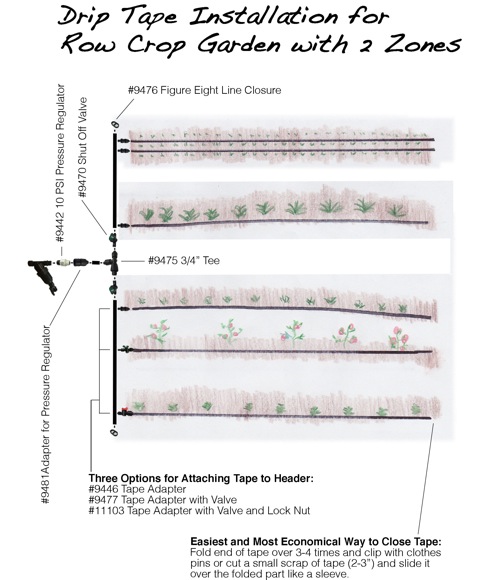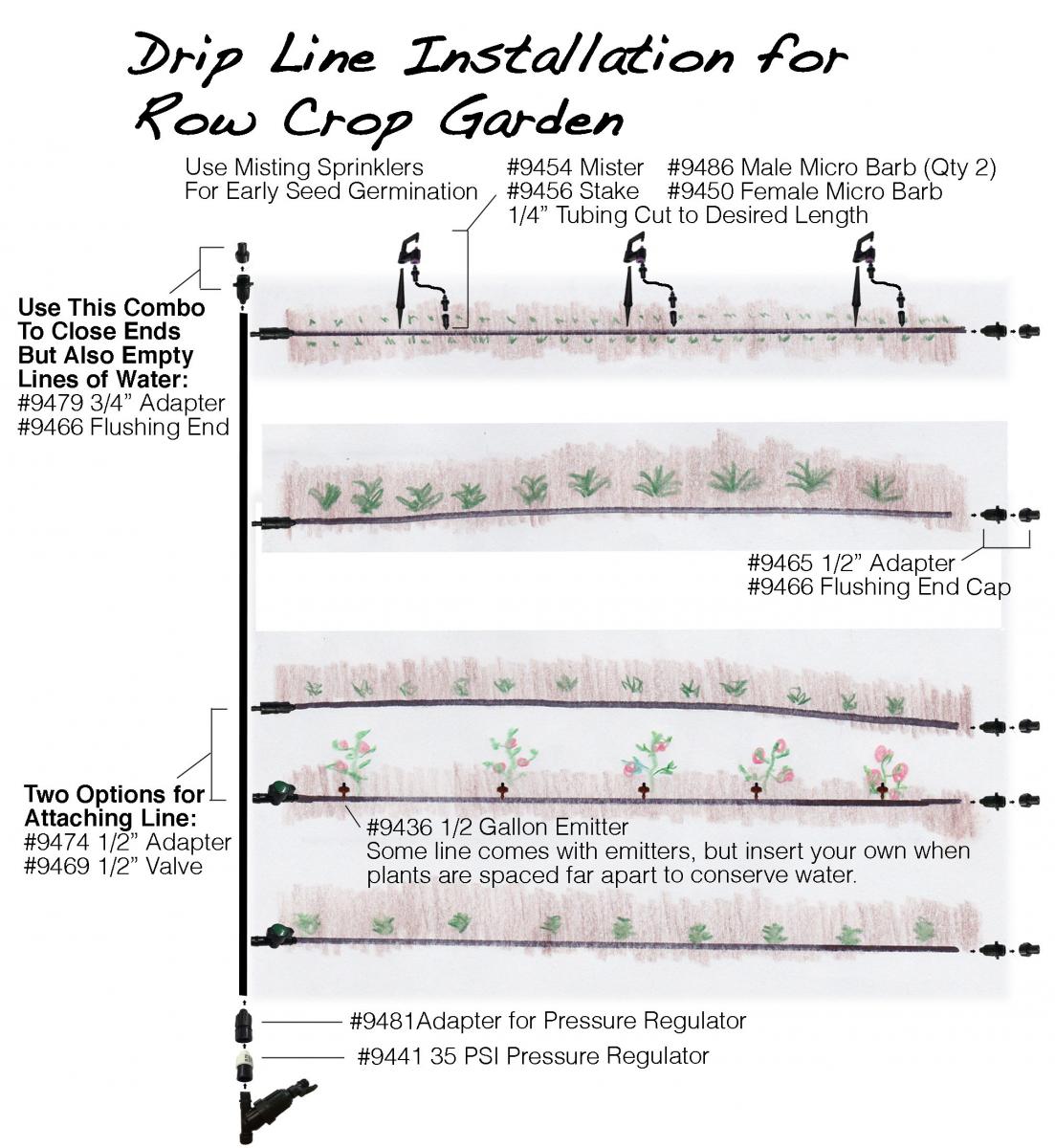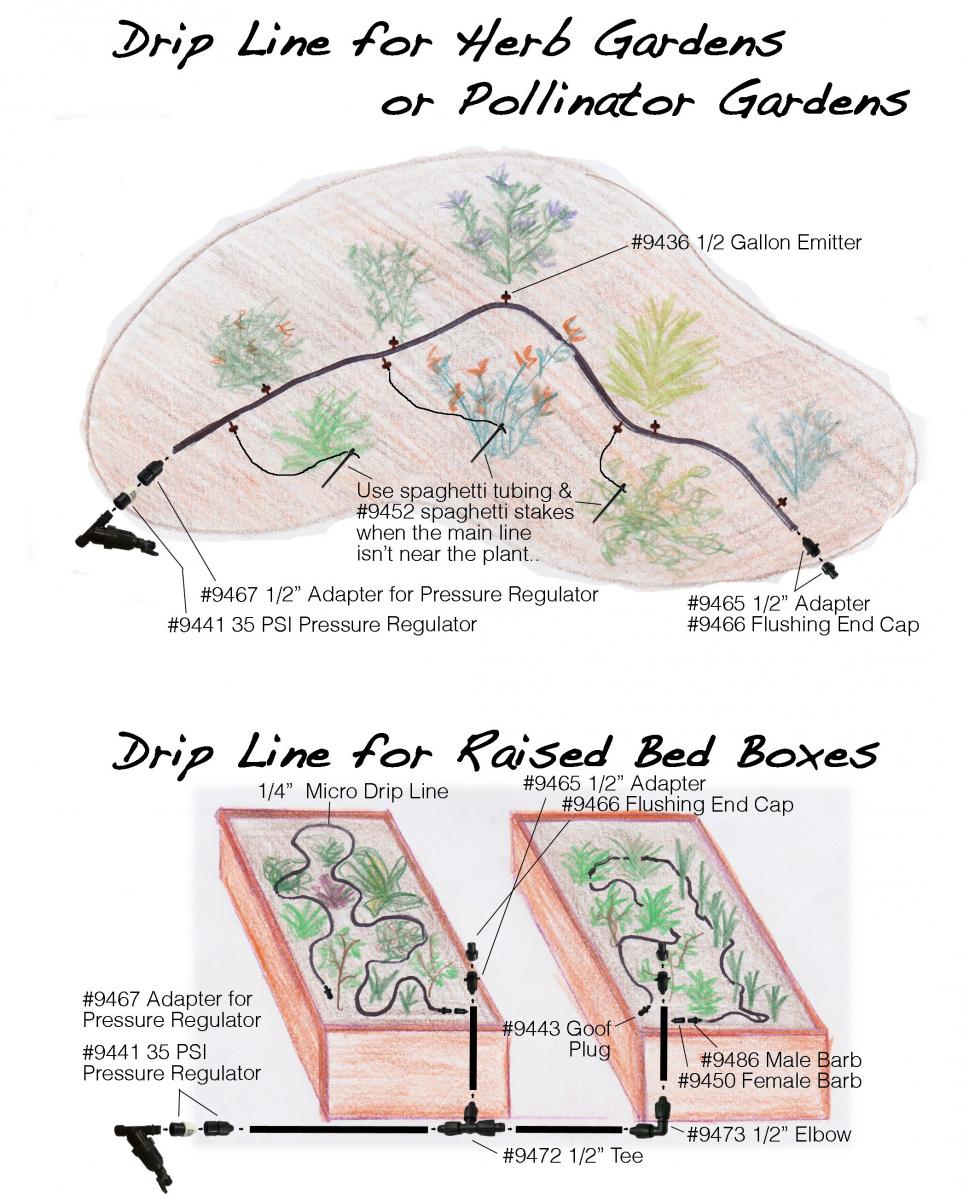Posted February 26th, 2025

Scroll to the bottom of this page for parts and pricing
Considerations Before Building A Drip Irrigation System
We highly recommend taking time to answer the following five questions before getting your feet too wet! (Scroll to the bottom for diagrams and pricing.)
1) Do you have enough water for the system you want to build?
Seriously! We’ve seen well-intentioned growers install whole systems without taking into consideration the output of the well, only to find that the well doesn’t support the system that was installed! So, here’s what you need to do…
Calculate how much water your well produces. Don’t know? Stick a 5 gal. bucket under a faucet and time how long it takes to fill. If it fills in 1 minute, you’ve got a 5 gallon/minute well. If it takes 10 seconds, then you could fill six 5 gallon buckets in a minute (6x5 = 30 gallons/minute). Have city water? Then most likely, you’re fine for whatever you want to do… as long as you have enough money to pay for it! Pumping out of a pond? If you already have a pump, do the 5 gallon bucket test at the pond, or if you are in the market for a pump, be sure to look at the pump’s max. GPM (gallons per minute).
Once you’ve figured well output, then you need to figure out how much drip irrigation your well will accommodate… Irrigation systems are measured in gallons per hour. A well that produces 5 gallons per minute will produce 300 gallons per hour (5 gallons x 60 minutes). Most drip tape systems put out ¼ gallon per hour at each emitter. Drip line systems can put out ½ gallon or 1 gallon per emitter or sometimes more depending on what you are watering. So, for tape that puts out ¼ gallon at each emitter, a 300 gallon per hour well will accommodate 1200 emitters. If the emitters are spaced 12” apart, then that’s 1200 feet of irrigation. You can do the math to figure out any other scenario as long as you know how much water is coming out of each emitter and how far apart the emitters are spaced.
2) Do you need or want zones?
You can set up your irrigation system to water everything at one time or you can break it into zones so that sections of your farm or garden are watered separately.This can be handy if you are growing a diversity of crops that require differing water needs or are slated to go in and come out of the ground at different times.
If you found out in question #1 that your water supply will not support the amount of irrigation you wish to install, then the easiest way to deal with that problem is to water in zones.
3) Can you set up your system where water flows downhill?
When working with water, gravity is your friend, so use it, don’t work against it!If you are running underground plumbing out to your garden, consider installing the hydrant at the highest point so all water will flow downhill.Remember that drip irrigation systems are low pressure systems, and you are sure to lose additional pressure if you must push water uphill, especially over longer distances.
4) What size header pipe do you need?
Typically, you’ll see folks working with ½”, ¾”, and 1” header, although some larger farms will use larger diameter pipe.Basically, the larger your water needs, the more room you better have for your water to move.Otherwise, it’s like putting too many cars on a small road… you get a traffic jam and everything slows waaaaaayyyy down!Here’s a very general rule of thumb we use…
½” header = very small home garden, landscape bedding around home (systems using less than 240 gallons/hour)
¾” header = most large home gardens & small farms (systems using less than 480 gallons/hour)
1” header = larger farms – 2+ acres in dense production (systems using 500+ gallons/hour)
5) What’s the better choice for you: drip tape or drip line?
What’s the difference between tape and line? Drip tape is flat and thin and line is a firmer, poly tubing, coming in various diameters.Here are a few comparisons between line and tape to help you make a decision…
Drip Tape
- Lower up front costs – cheap to buy
- Disposable – may keep 1-3 seasons
- Easy install – standard straight lines
- Pressure Needs - 10psi
- Repair – rodents tend to chew holes
Drip Line
- Lower long term costs – lasts a long time
- Low Waste – can stay in field 10+ years
- Versatile - misters, varied emitters, curves
- Pressure Needs - 35 psi
- Repair – low maintenance
Can you use tape and line simultaneously? Yes, but they do require different pressures, so you will usually need to install a different pressure regulator somewhere in the system to change the water pressure.
Once you’ve addressed these five questions, then you can sketch out a plan, collect your parts, and start building!
Below are several diagrams of different scenarios we often see folks need help with when they come in the store. Scroll to the bottom of the page to get a downloadable parts and price list.




We now have wobblers! Click on the link below for updated pricing and parts!